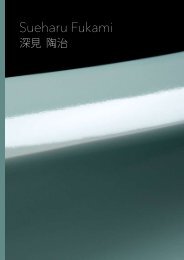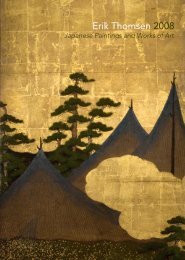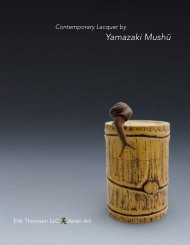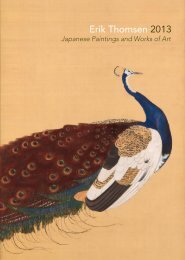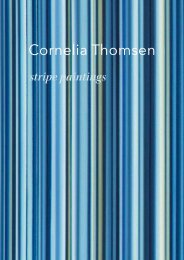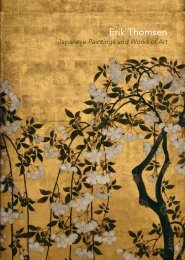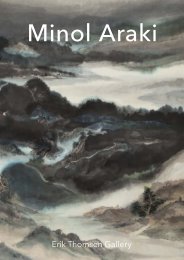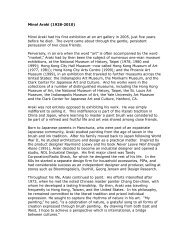View publication (pdf file 6.5 mb) - Erik Thomsen
View publication (pdf file 6.5 mb) - Erik Thomsen
View publication (pdf file 6.5 mb) - Erik Thomsen
- No tags were found...
Create successful ePaper yourself
Turn your PDF publications into a flip-book with our unique Google optimized e-Paper software.
27Writing Box with Fans andAutumn GrassesMeiji Period (1868 –1912), circa 1900H 1½" × L 8" × W 7 ¼"(4 cm × 20.4 cm × 18.4 cm)Maki-e lacquer boxInscription (on box top): »Autumn grasses patternlacquer writing box« 秋 草 模 様 蒔 絵 硯 筥Inscription (on end of box): »Small type writing box,autumn grasses pattern, received from Mr. Nagata.«小 形 硯 箱 秋 草 蒔 絵 永 田 氏 ヨリThe two gold-lacquer fans on the cover of this superbrectangular suzuribako writing box distinctlystand out against the roiro mirror-black ground.The upper fan is decorated with a scene of chrysanthemumflowers by a ba<strong>mb</strong>oo fence and floweringtrees, rocks, waterfall and stream; the lowerfan with a palace building by a garden with pines,cherry blossoms and fence, all surrounded by goldenclouds. The décor is executed in finely-detailedhigh-relief takamakie gold, silver and red lacquerwith additional details in hiramakie and togidashilacquer and many inlays of irregularly-cut kiriganegold foil squares and triangles. The curved outsideedges of the box are lacquered in togidashi goldlacquer; the rims of the box and of the ink stone insideare in solid silver.The writing box contains numerous references tothe literary traditions of courtly Japan, specificallyto those of the Heian period, which was seen bymany as the pinnacle of Japanese cultural achievements.The décor on the cover refers to a Heiancourt tradition, the exchange of fans decoratedwith painting or calligraphy. 1 The building on thelower fan is in the Heian period shinden-zukuripalatial architecture style, with references to Heianperiod Tales of Genji paintings, which featuredsimilar settings with finely tended gardens. Ascan be seen in item 2 of the present <strong>publication</strong>,scenes from Genji were also painted on foldingscreens in the Momoyama and Edo periods andsuch compositions would have been familiar tome<strong>mb</strong>ers of the educated elite.The veranda of the palace building on the fan,however, is without its Prince Genji. The stage waslikely left open by the artist to impart a genericHeian flavor to the composition without anchoringit to a specific text or scene. Perhaps it was leftopen so that the owner of the writing box could imaginehimself in the role of the Heian-period aristocrat,about to open the box to brush a poem toa distant lover.Opening the writing box, one is rewarded witha dramatic view of a multitude of swaying fallgrasses, the Japanese pampas grass susuki 薄 , inhiramakie gold and silver lacquer with the roundsuzuri ink stone representing the full moon. Thisinner composition refers to the Autumn MoonFestival, the Jūgoya 十 五 夜 , which is often sy<strong>mb</strong>olizedby susuki and the full moon. The festival takesplace on the 15th day of the 8th month of thelunar calendar (usually mid- to late-Septe<strong>mb</strong>er inthe Gregorian calendar), a date that parallels theautumn equinox in the northern hemisphere. Thetraditional food for this festival is the round caketsukimi dango 月 見 団 子 , which echoes the shapeand color of the distant moon.The writing box comes complete with the originaltwo brushes, paper cutter and suiteki water dropperin the shape of shikishi poetry cards, all lacqueredin togidashi gold lacquer; and with the original kiriwoodfitted box.94 95



